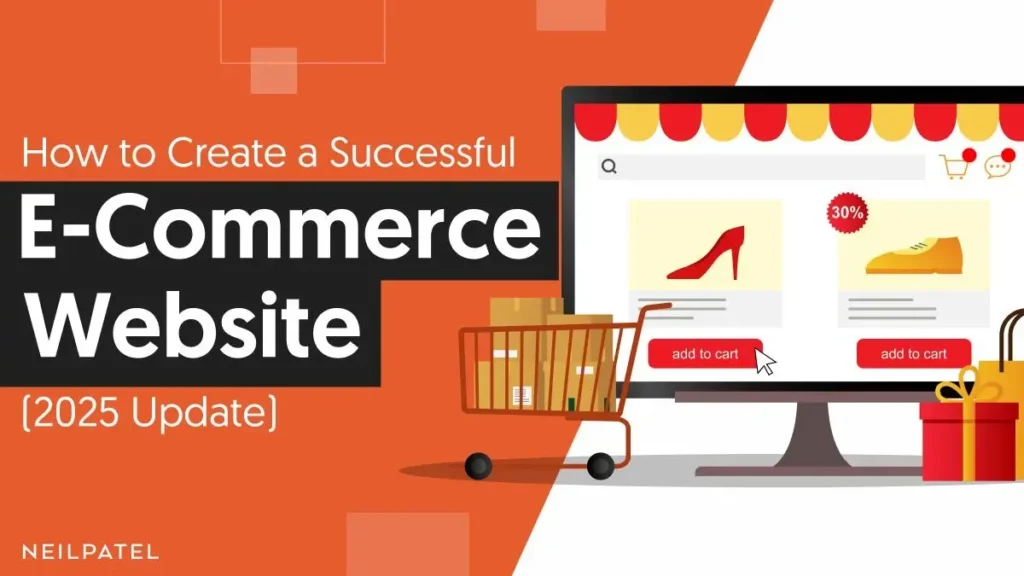Considering online sales? Wish to advance your business? An online retail site can help you attain an international audience and earn revenues 24/7. As a new company or a well established brand, ecommerce websites allow you to be on your own -no more middlemen- in terms of branding and of making profits.
In this guide we will step you through all the details you will require to create and expand a strong online store. Whether it is about selecting the finest ecommerce website builder or knowing about pricing, features, SEO and ecommerce Web Design trends, you shall have a step by step guide to online success. And let me dig in!
What is Ecommerce Web site?
The ecommerce site is an internet site that allows the business or parties to sell products or services on the internet. Consider it a virtual shop-front through which users can shop by browsing through the product, putting them in a shopping cart, and making a payment without the need to move out of their home.
Amazon, Nike, and Etsy are among some of the greatest ecommerce sites. However, being a giant is no requirement to succeed and there are plenty of small ecommerce websites in business conveniently located on the Internet because of clever design and smart marketing.
Key Steps in Ecommerce Website Development
1. Choose Your Niche
A niche ecommerce website often converts better. Whether it’s fashion ecommerce websites, grocery ecommerce websites, or digital product stores, narrow your focus for targeted sales.
2. Select the Right Ecommerce Platform
Here’s a quick comparison of top ecommerce platforms:
| Platform | Best For | Notes |
| Shopify | All business sizes | App-rich and easy to scale |
| WooCommerce | WordPress users | Open-source and flexible |
| Magento | Enterprises | Advanced features |
| Wix | Beginners | Drag-and-drop simplicity |
| BigCommerce | Growing brands | Multichannel ready |
| Squarespace | Creative stores | Stylish and simple |
Choosing the best ecommerce CMS depends on your budget, goals, and tech skills.
3. Pick a Domain & Hosting
Choose a memorable domain and opt for reliable ecommerce website hosting like Bluehost, SiteGround, or platform-hosted solutions like Shopify.
4. Focus on Design & UX
A good ecommerce website layout should be clean, responsive, and fast. Prioritize:
- Mobile-friendly ecommerce website experience
- Smooth ecommerce website navigation
- Effective ecommerce product page design
- Trust elements like reviews and secure badges
5. Add Features & Payment Options
Must-have ecommerce website features include:
- SEO tools
- Secure checkout
- Promo code functionality
- Customer accounts
- Advanced analytics
For payments, integrate gateways like PayPal, Stripe, or regional providers.
Ecommerce Website Design Follow the Guidelines
Modern ecommerce website designed of the UI/UX is:
- Basic ecommerce design
- Mobile ecommerce user experience is one of the most difficult ecommerce challenges out there.
- Blazing fast ecommerce site
- Sticky carts. Rapid check out
- Smart search & filters
In addition, include a blog to work ecommerce content marketing and also enhance ecommerce website SEO.
Use tools like Hotjar, Google Optimize, or Shopify Analytics for data-driven tweaks.
Smart SEO & Marketing
- On-Page SEO
- Use a good ecommerce keyword strategy with words like
- Ecommerce website developing
- 100 Steps to Make ecommerce site
- Cost of Ecommerce website
Meta titles, product descriptions, alt text and URLs should be correctly optimized for ecommerce product SEO.
- Content Marketing
- Blogging causes you to:
- Beat for long description key phrases
- Deal with frequently asked questions.
- Seo subdomain
- Get Internal linking
Also, try to secure ecommerce backlinks from particular directories, PR or influencer mentions.
CRO & Funnel Optimierung
Focus on:
- Ecommerce landing page optimization
- Try Out Different Layouts and CTAs with A/ B testing
- Ecommerce checkout design minimal
- Recovering carts emails
Tools in the likes of the Hotjar, Google Optimise, also Shopify Analytics for data first enhancements.
Ecommerce Website Examples & Inspiration
| Website | Industry | Why It Works |
| Allbirds | Footwear | Clean design, ethical branding |
| Bite Toothpaste | Eco-products | Subscription model & visuals |
| Nike | Fashion | Dynamic product displays |
| ASOS | Clothing | User reviews & variety |
| IKEA | Furniture | AR previews & product filters |
Check out ecommerce website examples on Awwwards, ecomm.design, and Dribbble for layout ideas and inspiration.
International Ecommerce Websites Going Global
In case you intend on making a global expansion, it is worth to remember:
- Ecommerce in multiple languages
- Shipping & taxes local
- Cultural predilections among ecommerce homepage design
- Safe shopping in native currencies
- Domains/subfolders by country
This practice will improve the conversion and gain the trust of more people.

Specific Business Model Ecommerce
- Dropshipping ecommerce store: Sell without inventory (e.g. Oberlo, Spocket)
- Multi-vendor e-commerce: Allow other people to sell through your site (such as ETSY)
- Handmade merchandises ecommerce: Superb on artists and crafters
- B2B commerce site: Provide business accounts, wholesale prices and invoices
- Ecommerce blogs: Subscription channels, memberships: Subscriptions, boxes
Customize your site by the way you need and your customers.
Ecommerce Website Pricing Guide
Pricing depends on the scale and tech stack:
| Type | Price Range |
| DIY Builders (Wix, Shopify Basic) | $0–$2,000 |
| Custom Design & Development | $5,000–$20,000 |
| Enterprise Solutions (Magento, BigCommerce) | $20,000–$100,000+ |
| Ongoing Costs | Hosting, add-ons, marketing, transactions |
Check your goals and scale accordingly.
Quick Checklist: How to Create an Ecommerce Website
✅ Pick your product niche
✅ Choose your ecommerce platform
✅ Register a domain and hosting
✅ Install or select a responsive theme
✅ Add products, images, and SEO-friendly descriptions
✅ Set up payments, taxes, and shipping
✅ Enable reviews, analytics, and social integrations
✅ Test thoroughly before going live
✅ Promote through SEO, social, and ads
Rapid Fire: How to Build an Ecommerce site
Choose what you want to produce
Select your ecommerce platform
Claim to a domain and hosting
Select/Install a responsive theme
Upload products, photo and optimized descriptions
Install payments, tax, and shipping
Allow reviews, analytics and integration with social sites
Exhaustive testing prior to coming online
Market via ads, social and SEO
Conclusion:
A good ecommerce site uses fine technology, user-friendly design and properly optimized content. Your ecommerce business can grow at an accelerated rate, regardless of whether you are starting a new brand, considering drop shipping or setting up a B2B online store. Use these tips, select your platform carefully, and remember what your customers really need: convenience, trust and quality. It is time to become a successful online merchant.
Meta Description:
Find out how to start a successful ecommerce store in 2025: leading tips on design, comparisons of builders, prices and strategy to grow a business globally.


